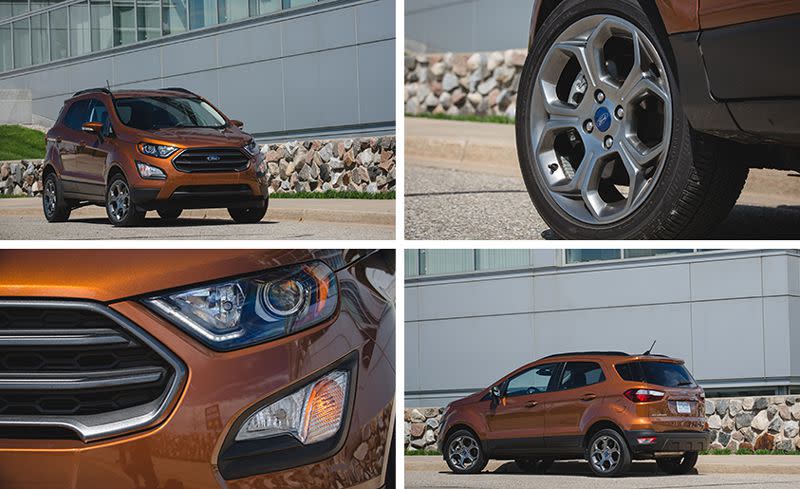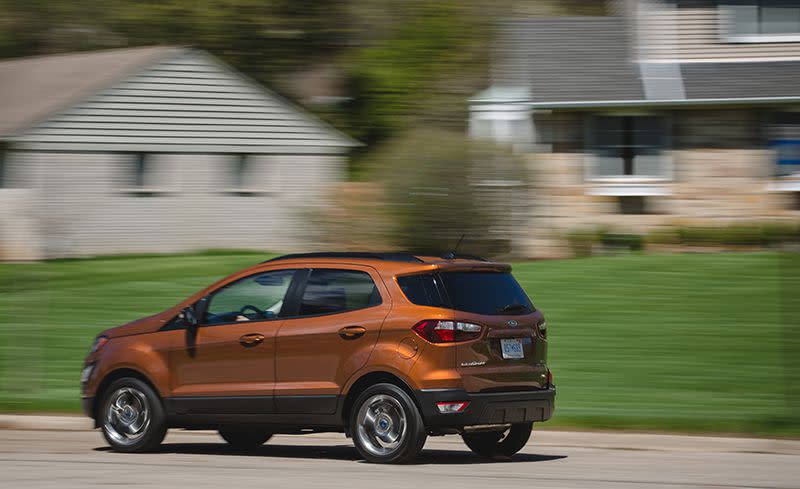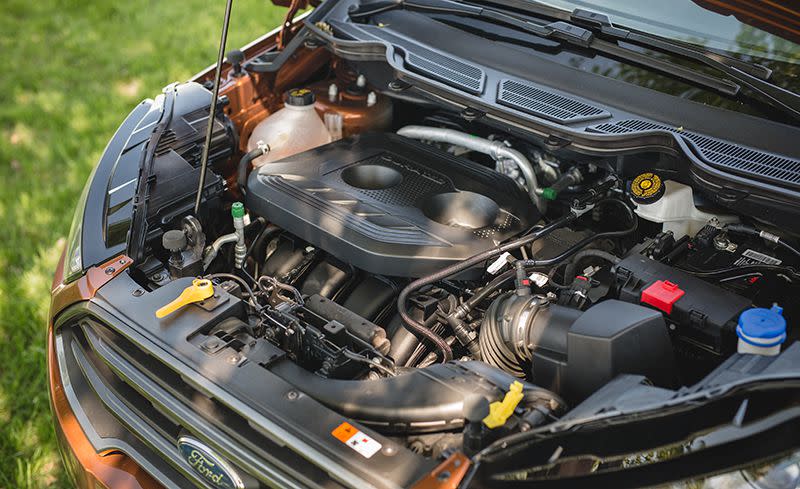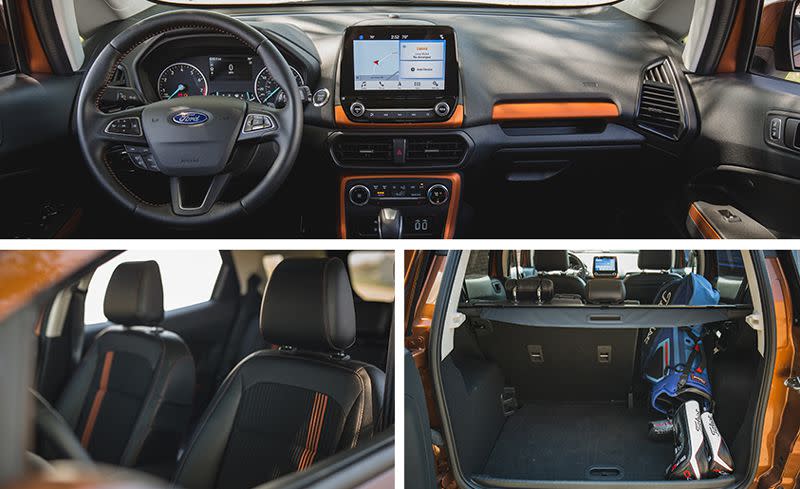The Ford EcoSport May Actually Be Too Small
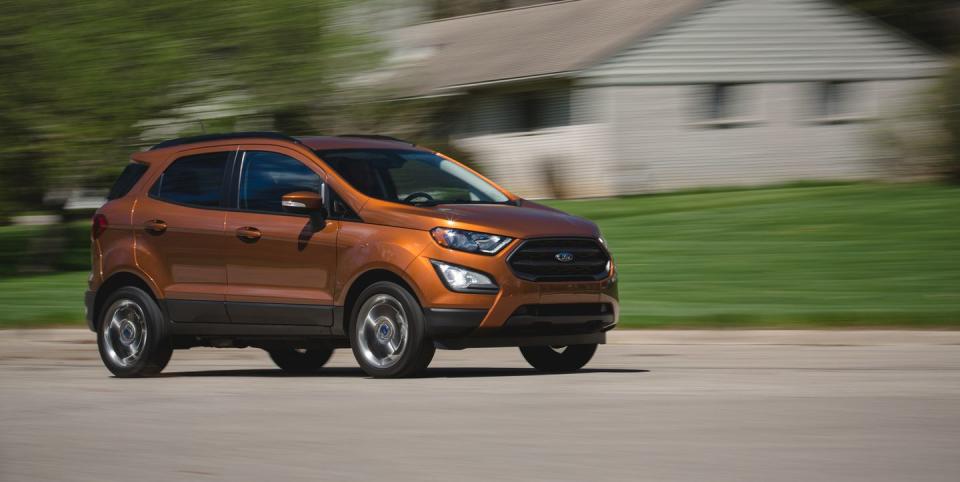
If the Ford EcoSport were a car, it would be a very small one. A tad shorter than the Honda Fit and barely longer than Ford’s own Fiesta hatchback, the thirteen-and-a-half-foot-long EcoSport soon will be FoMoCo’s littlest and likely its least expensive vehicle sold in the United States, once the company’s plan to kill off all its passenger-car nameplates runs its course.
View the EcoSport through the lens of its market segment, though-the subcompact-SUV segment that includes rivals such as the Jeep Renegade, the Mazda CX-3, and the Honda HR-V-and the Ford starts to look positively Lilliputian. It’s some five inches shorter in length than the Jeep, seven inches littler than the Mazda, and almost eight inches stubbier than the Honda.
EcoSport without EcoBoost
With that tiny of a shadow, the EcoSport is just about the smallest U.S.-market vehicle we can think of that can be had with all-wheel drive, the feature that many SUV shoppers consider a must-have. The EcoSport tested here was so equipped, which means it also comes with an engine that’s double the size of the one found in its front-wheel-drive stablemate. Checking the box for AWD costs around $1500, depending on trim level (except on the SES where it’s standard), and it necessitates a switch from the turbocharged 1.0-liter EcoBoost inline-three to a naturally aspirated 2.0-liter inline-four, which makes 166 horsepower and 149 lb-ft of torque.
Despite its diminutive size, the EcoSport 2.0L AWD weighed in at a hefty 3386 pounds, 240 more than the front-wheel-drive EcoSport (and around 300 pounds more than equivalent CX-3s and HR-Vs we’ve tested). That meant its extra 43 horsepower and 24 lb-ft of torque couldn’t register much of an improvement over the 1.0-liter car’s painfully slow 10.4-second run to 60 mph. The 2.0-liter EcoSport was 0.6 second quicker to 60 and also took an interminable 17.5 seconds to run the quarter-mile (0.4 second quicker than the 1.0-liter).
As you’d expect from something so tall and narrow, the EcoSport has a somewhat tippy feel when you push it hard in corners. There’s no real reason for concern in the era of stability control, of course, but the EcoSport’s handling and braking numbers of 0.79 g of grip on the skidpad and 182 feet to stop from 70 mph are near the back of the pack, and the steering feels overboosted and vague. The ride is smooth enough on good pavement, but large bumps and uneven surfaces send reverberations through the cabin, cheapening the driving experience.
Bigger Is Better
Surprisingly, the AWD EcoSport’s extra cylinder, additional drive wheels, and larger-displacement engine didn’t have a negative impact on fuel economy. Quite the opposite, actually, as the smaller engine needs to work harder-the 2.0-liter version bettered the 1.0-liter car by 2 mpg in our highway fuel-economy test, hitting 30 mpg, although that’s still disappointing for a vehicle of this size. We achieved 24 mpg overall. Not that the 2.0-liter provides effortless power, however, as it still strains to get the EcoSport up to highway speeds. At least the six-speed automatic serves up unobtrusive shifts and generally chooses the correct gear.
Ford does get a fair number of things right inside the EcoSport. Although the cabin feels narrow, particularly in the rear seat, our SES test car was nicely trimmed (by the low standards of its competitive set). The tablet-style center touchscreen is easily reached and simple to use, with Ford’s Sync 3 infotainment system responding quickly to inputs and offering good smartphone connectivity. Dashboard materials are well chosen, the climate controls are clearly marked, and things such as the USB ports are easily accessible. We’re not quite sold on the loud orange accents that come standard on the SES, but they do jazz things up a bit.
And we can admire the packaging engineers’ ability to fit a decent amount of cargo space inside this compact footprint. The side-opening tailgate reveals a cargo floor that’s nice and low, and a movable panel allows you to choose between either a deeper well or a flush floor with the 60/40 rear seatbacks folded. Five carry-on suitcases fit behind the second row, better than the CX-3 and the Kia Soul, and 18 suitcases can be stuffed in with the rear seats folded.
The Price of Smallness
That said, the EcoSport is so short that we imagine it would be a struggle to get larger items in there-a bicycle without the front wheel removed definitely wouldn’t fit, for instance. A kayak would look positively comical strapped to the EcoSport’s roof. Isn’t a crossover meant to accommodate these types of active-lifestyle items? That’s what the marketing says, at least, and the EcoSport’s size seems to be one of its main limitations.
The idea of paying $27,875 for such a little car is perhaps the most distasteful aspect of the EcoSport. And the SES model doesn’t even come well-equipped enough to justify that price: Active-safety features such as automated emergency braking and lane-departure warning, for instance, aren’t offered at all on the EcoSport, while they’re becoming standard on more competitors. The base EcoSport S may be more palatable in the low-$20,000 range (and it can be had with a retro-cool rear-mounted spare tire!), but even at that price point there are numerous competitors that offer a whole lot more of everything-equipment, driving pleasure, and outright size-than does the EcoSport.
You Might Also Like

 Yahoo Autos
Yahoo Autos 